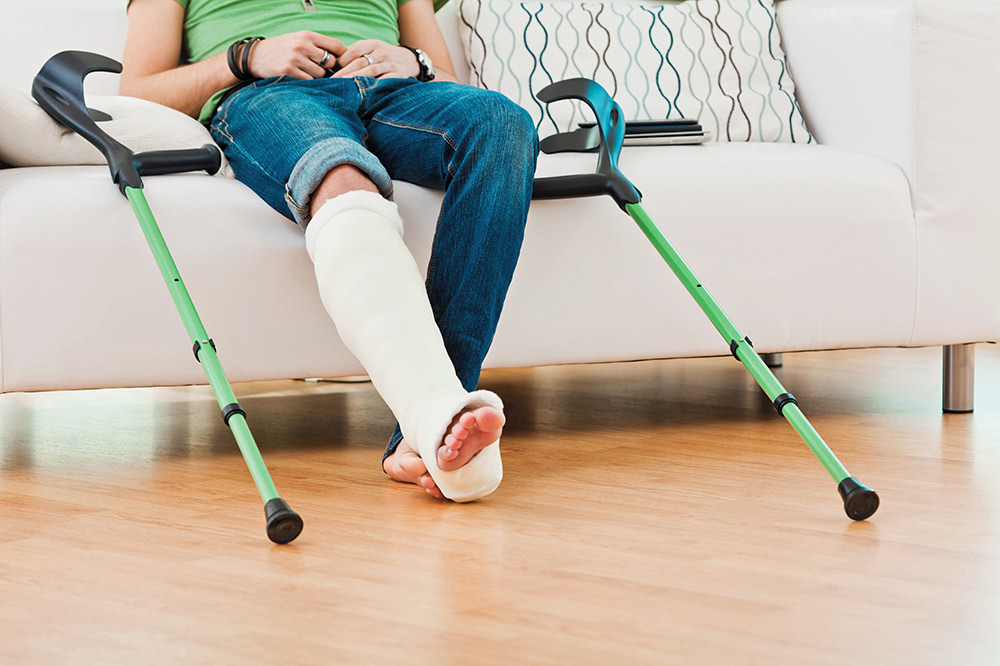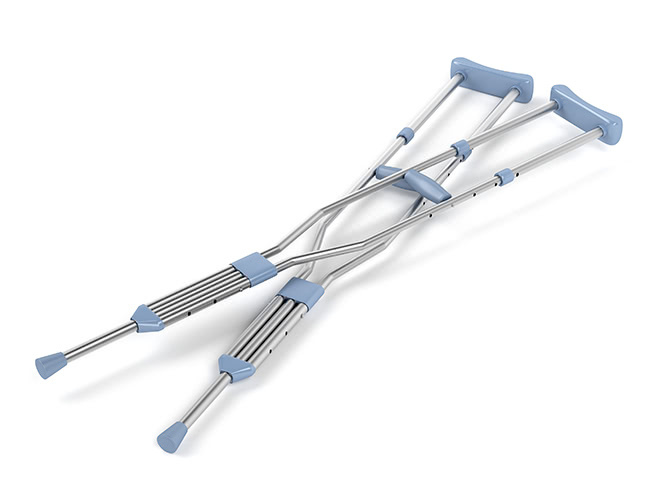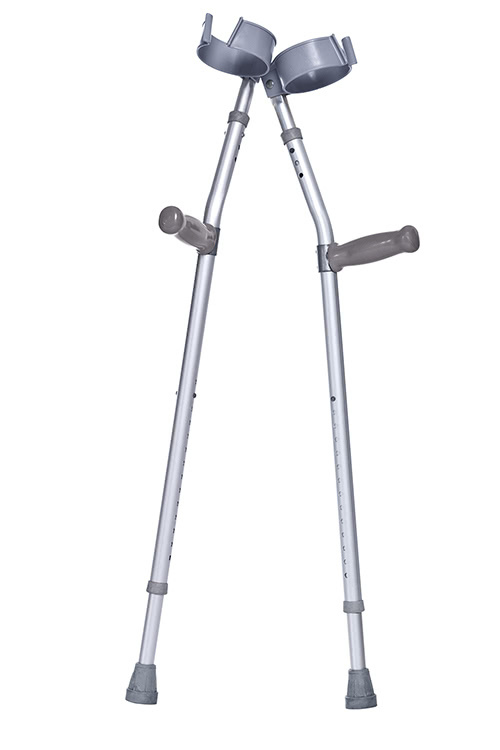
Are you currently facing a surgery that will have you on crutches for several weeks and wondering how to use them properly? Or are you perhaps using crutches already after injury but are experiencing more discomfort than you’d like?
In either case, it’s important to know how to use crutches safely. This will help you avoid pain and further injury and maximize your ability to safely get around while you heal. Here are a few tips to ensure you understand how to walk with crutches so you can speed that healing along and get back to life as you know it ASAP.
1. Get the right set
Not all crutches are the same, and you should be starting with a pair that is suited to your needs and body. Your physician will make recommendations, but it may take a little trial and error to figure out what works best for you.
In addition to starting with the right size for your height and build, there are two types of crutches to choose from: the traditional underarm crutches or forearm crutches.

- Underarm crutches are what most of us think of when we picture crutches. They tend to be a good option for most anyone with a short-term injury since they don’t require much upper body strength to operate and are pretty straightforward to use. Unfortunately, they also leave plenty of room for error and are known to often place too much pressure on the underarms, leading to chafing, muscle pain, or even compressed nerves. If not properly fitted, they can also cause additional injury or discomfort from hunching over the crutches. Ultimately, they are easier to use and balance but less comfortable than other options.

- Forearm crutches are most often recommended for injuries or conditions that require long-term healing. That’s because while they do require more upper body strength to operate and move correctly, they tend to put less strain on the body and provide greater control in movement—particularly when it comes to stairs or uneven surfaces. They can be a little trickier to coordinate so may not be suitable for everyone.
Your doctor can help you determine what type of crutches are a good fit for you based on your injury, anatomy, and lifestyle.
2. Make sure your crutches are the right height for you
The first step in mastering your crutches is to ensure they are positioned at the right height. It may sound basic, but we can’t tell you how many folks get this one wrong—and how much discomfort it can cause.
Australian casino no deposit bonus
If you are looking for an Australian casino with a minimum deposit, then you are in luck! In addition to the fact that the minimum deposit can be $1, you will also receive free spins and a welcome bonus as a gift. So the list – casinos online Australia. If the offer is of interest, then hurry to try your luck. Check out the Australian casino whistle.
Have fun and earn money with us, the main rule is everything in moderation. And then everything will be fine!
When underarm crutches are too high, they can impede the mobility of your arms, which makes it difficult to move the crutches properly in addition to putting a lot of strain on your underarms. Essentially, you’d be trading one pain for another. Conversely, if crutches are too low, you can inhibit healing since you aren’t taking enough pressure off of your injured leg or foot—and constant hunching can cause back issues.
So, how do you figure out the right height? Ask your doctor to assist or enlist the help of a friend. Wearing the shoes you plan to wear most often for your recovery, stand up straight and have someone “eyeball” the first adjustment as a starting point. Some crutches even have height-based guidelines. Once the crutches are in the general area of your armpit or forearm, you can start tweaking for the proper fit. Here’s what to look for.
For underarm crutches:
- When hanging loosely at your side with elbows slightly bent, your wrist should be even with the handle, which should be right around the height of your hip.
- Your helper should also be able to fit two fingers between the top of the crutch and your armpit when you’re standing straight.
- Your crutches should never be positioned flush against your armpit when you’re standing straight.
For forearm crutches:
- Standing normally, bend your elbow about 30 degrees so that your wrist lines up with your hips. The grip handle of the crutch should be level with your wrist.
- The open end of the cuff should face away from your body and be positioned around 1-2 inches below your elbow near the thickest part of your forearm.
3. Learn how to walk and navigate stairs carefully
Once you’ve got your crutches adjusted to your body, it’s time to figure out how to use them. Learning how to avoid pain while using crutches means learning to walk in a completely new way. Proper technique is vital and may not come immediately, but it’s key to avoiding further injury.
First, you have to learn to break the habit of stepping with your injured leg, which can be particularly challenging if it’s your dominant side. Remember, your crutches should become an extension of you and your injured leg. Your doctor will let you know in advance how much weight you can put on your injury, and the way you operate your crutches may differ depending on whether or not you have a weight bearing or non-weight bearing injury.
Your doctor will order one of the following weight bearing designations—and you should always follow your healthcare provider’s advice:
- Non-weight bearing (NWB) means you cannot place any weight on your injured leg at all. Your foot must be held up off of the floor when standing or walking.
- Toe touch weight bearing (TTWB) is when you can rest your toes on the ground for balance, but you cannot place any of your body weight on the injured leg.
- Partial weight bearing (PWB) indicates that you can place a certain percentage of your body weight on your affected leg. Your physician will tell you how much weight is acceptable.
- Weight bearing as tolerated (WBAT) means that you can place some weight on your injured leg, as long as it feels comfortable. Discomfort guides how much weight you can bear, and you should put less weight on the leg if it begins to hurt.
- Full weight bearing (FWB) is when you can put your full body weight on your leg when you walk or stand.
Generally speaking, your goal is to always either be supporting your weight with your uninjured leg or with your crutches. When walking, move both crutches a little way in front of you, about the distance of your natural step, so your body and crutches from a tripod—you shouldn’t need to strain your arms forward or hop when moving your legs. Supporting your weight with your good leg, move your injured leg to where the crutches are positioned. Then, shifting your weight to the crutches, swing your body forward so your uninjured leg falls in line or just slightly past the crutches.
When climbing stairs, there are two techniques you can use, depending on whether or not a handrail is present. If there’s no handrail, stand close to the step with your crutches at ground level taking your weight and lift your uninjured foot to the first step. Once it’s settled, shift your weight to that leg and then bring up your crutches and injured foot together.
If there is a handrail, place both crutches in one hand and grab the handrail with the other. Lead with your uninjured leg and distribute your weight between that leg and the handrail as you’re ascending with your bad leg.
Whichever stair-stepping technique you’re using, be sure to check your balance before moving to the next step.
4. Learn how to stand up properly
What about when it’s time to sit down and stand back up? One of the most important skills to master when you’re learning how to use crutches is getting up from a chair without further hurting yourself. This is a tricky transition, because while you rise and before you put your full weight on the crutches, there is danger you will hurt yourself by putting too much weight on the injured area.
The proper technique is to hold both crutches by the handle in the arm on the same side of your body as the injured leg. The other hand you use to push you up from chair or bed, standing only on your good leg. Once standing, switch one crutch to your other hand, making sure you are well-balanced on your uninjured leg so you don’t feel the need to step down on your injury.
Your friends at Carolina Hand & Sports Medicine have got your back (and your leg or foot or knee)
Whether your injury requires you to use crutches or not, living in pain can greatly impact your quality of life. Our team of orthopedic surgeons and specialists have years of experience diagnosing and treating a variety of conditions and injuries with compassionate care and advanced techniques and technologies. Contact us today to learn more about your options and get started on living a comfortable, full life.
